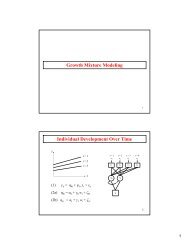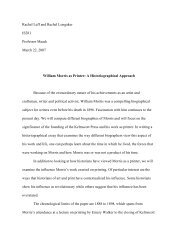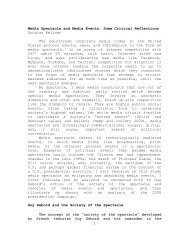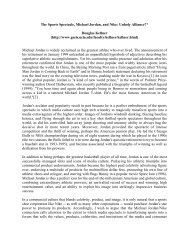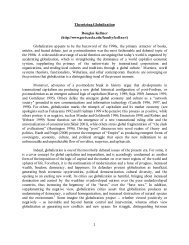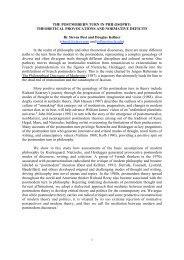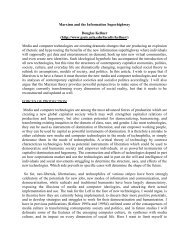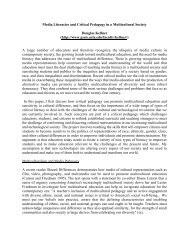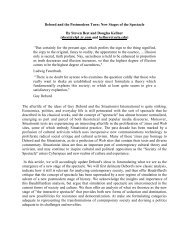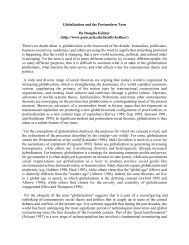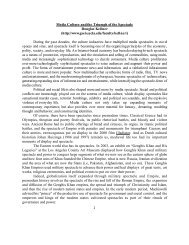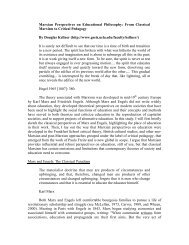Rap, Black Rage, and Racial Difference Steven Best and ... - UCLA
Rap, Black Rage, and Racial Difference Steven Best and ... - UCLA
Rap, Black Rage, and Racial Difference Steven Best and ... - UCLA
You also want an ePaper? Increase the reach of your titles
YUMPU automatically turns print PDFs into web optimized ePapers that Google loves.
<strong>and</strong> its 'Don't forget the Trojan.'"<br />
In a postmodern media culture, there is evident pleasure in quotation, sampling, <strong>and</strong> mixing<br />
material from different sources <strong>and</strong> eras. Houston Baker accordingly describes rap as<br />
"postmodern" by virtue of its "nonauthoritative collaging or archiving of sound <strong>and</strong> styles that<br />
bespeaks a deconstructive hybridity. Linearity <strong>and</strong> progress yield to a dizzying synchronicity"<br />
(1993: 89). Like other postmodern artistic products, rap is eclectic <strong>and</strong> pastiche-oriented, <strong>and</strong><br />
subverts modernist notions of authorship. But from the perspective of Jameson's concept of<br />
postmodern culture, marked by depthlessness, the absence of affect, the disintegration of the<br />
authorial voice, <strong>and</strong> so on, rap appears to be modernist in form. Creating highly expressive<br />
modernist collage, the best rappers have distinct voices, styles, <strong>and</strong> messages, often related to<br />
modern politics. Thus, rap draws on both modernist <strong>and</strong> postmodernist strategies <strong>and</strong> is between<br />
the modern <strong>and</strong> the postmodern (for further explication of this claim, see Kellner 1995: 147f).<br />
A Sense of Time <strong>and</strong> Place<br />
When listening to rap, one immediately notices that it is a form of articulating identity <strong>and</strong> selfassertion.<br />
The rap artists frequently call attention to their origins, usually grounded in a particular<br />
region like South Central Los Angeles, the Bronx, or Compton; thus there is a highly articulated<br />
awareness <strong>and</strong> sense of place in rap music. In particular, rap is frequently a music of the 'hood,<br />
that arises from distinct neighborhoods where identification with place supplements the strong<br />
identification with race <strong>and</strong> is certainly stronger than identification with the nation.<br />
<strong>Rap</strong> also functions as a means of affirming <strong>and</strong> constructing individual identities for the group<br />
or rap artist. This identity may border on narcissism <strong>and</strong> a materialism that brags of its record<br />
sales <strong>and</strong> material possessions, as well as a macho bravado that boasts of being kick-ass tough,<br />
but it is also a key mode of assertion in an environment hostile to any form of African-American<br />
self-expression. It also situates the rap artists in their specific milieu, gaining identity <strong>and</strong><br />
authenticity from being located in a specific space <strong>and</strong> time.<br />
<strong>Rap</strong>pers also frequently state the time in which they are rapping ("Ice-T, 1991, mother fucker,<br />
you should have killed me last year"). They are frequently asking the question, "What time is it?"<br />
<strong>and</strong> answering: Time to Wake Up! Flavor Flav of Public Enemy wears a clock around his neck<br />
<strong>and</strong> rappers situate their work in a specific time <strong>and</strong> place, often signalled in music videos by<br />
newspapers, graffiti, or graphics, as well as the lyrics. <strong>Rap</strong> tells us that it is the time of conflicts<br />
between the dominant <strong>and</strong> subordinate race, gender <strong>and</strong> class forces, that it is time for change,<br />
that it may be the fire this time, that apocalypse is on the horizon, that its time for change.<br />
Thus, rap undercuts the placelessness, timelessness, <strong>and</strong> contextlessness of much popular music,<br />
especially the schizophrenic play of signifiers of music video, with a drive to contextualize,<br />
narrativize, <strong>and</strong> signify. The rap singer wants you to know who she or he is, where they are from,<br />
what time it is now, <strong>and</strong> what is happening. The images of the music videos show specific urban<br />
sites, often the ghettos of the underclass. Ice T's videos of the songs in "Original Gangster" show<br />
him in the 'hood, experiencing the stories he narrates in his songs, as do many videos of N.W.A.,<br />
Ice Cube <strong>and</strong> other ghetto-based rap artists. The images <strong>and</strong> lyrics show <strong>and</strong> tell us that it is a<br />
time of intense poverty <strong>and</strong> differences between the haves <strong>and</strong> the have nots, that it is a time of




